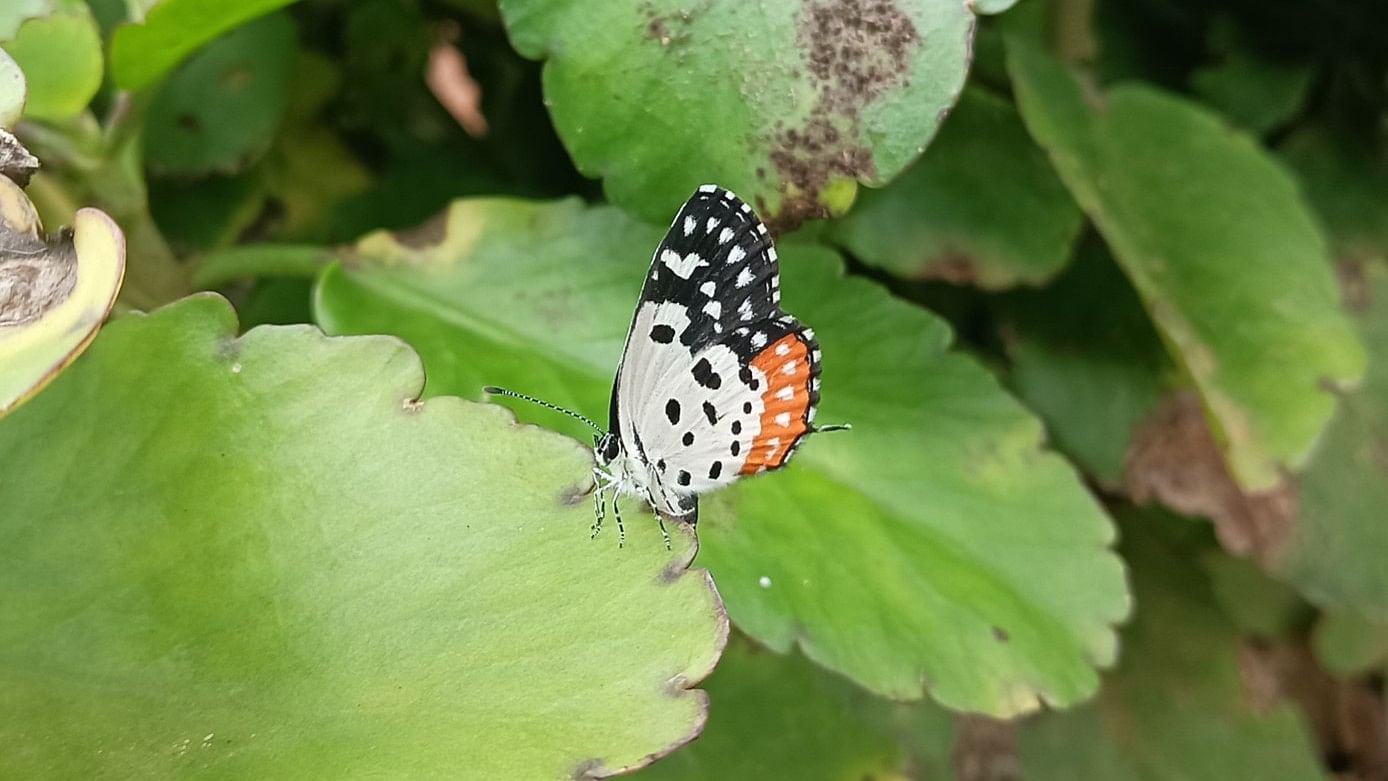
Red Pierrot butterfly.
Credit: Kunal Ankola
Karnataka is home to a diverse array of butterfly species. Many of these species are known for their vibrant wing colours, while others are recognised for their migratory patterns.
However, some butterflies in this region neither migrate nor exhibit striking colourations on their wings. Some are quite diminutive or have limited flying capabilities, often overlooked by butterfly observers and enthusiasts.
Among some ‘lesser-known’ species is the Red Pierrot, which showcases a distinctive and intriguing lifestyle that sets it apart from other butterflies.
The Red Pierrot is a common, nonseasonal butterfly found in Karnataka. It is classified within the Lycaenidae family, which is recognised as the second-largest family of butterflies, encompassing more than 6,000 species. These small butterflies are frequently located near their host plants. Like other species within the Lycaenidae family, they remain close to their host plants and do not engage in long-distance flight.
Despite being weak fliers, red pierrots are widely distributed across the Indian subcontinent. Like other butterfly species, adult red pierrots obtain nourishment by feeding on flower nectar. Additionally, they may partake in puddling behaviour, which allows them to gather essential minerals from moist clay and soil and occasionally from human sweat.
Generally, red pierrot females deposit around 60 to 80 eggs on the lower side of the leaf of their host plant. These eggs are small, ellipsoid in shape, and have a greenish-white colour. They typically hatch within a period of 8 to 10 days. Kalanchoe, a member of the Crassulaceae family, acts as a host plant for the red pierrot butterfly.
Kalanchoe is a succulent plant characterised by its thick, hydrophobic leaves, which play a crucial role in minimising water loss through a process known as transpiration. Female red pierrot butterflies exhibit selective behaviour in identifying their host plants by assessing particular chemical signals derived from the leaves, subsequently laying their eggs on these selected plants.
What makes it unique
The life cycle of the Red pierrot butterfly is distinct from that of other butterflies. It starts with the larval hatching from the eggs. Unlike other butterfly species, the egg shells do not serve as the first meal for the red pierrot larvae. The larvae forego feeding on their eggshell and instead directly consume the leaves of their host plant.
Feeding on the Kalanchu leaf poses a challenge for these larvae due to its thick protective layer. Unlike most butterflies, the red pierrot larvae cannot consume the leaves entirely from the outside because their mouthparts are not suited for this task. The larvae employ a unique strategy to address this issue that distinguishes them from other butterfly species.
They create a small hole in the leaf, enter it, and feed on the mesophyll tissues between the upper and lower epidermis. This specialised feeding behaviour is crucial for the larvae’s development, allowing them to feed on a nutrient-rich plant while providing shelter and protection.
The larvae remain inside the leaf for 8 to 10 days before emerging for pupation, which lasts approximately 12 to 15 days until the adult butterfly emerges.
The female-biased sex ratio
The female-biased sex ratio is when the number of females surpasses that of males within a specific brood. In the case of the red pierrot butterfly, this imbalance is attributed to an infection caused by a bacterium known as Wolbachia, which naturally targets reproductive tissues.
Wolbachia’s presence significantly modifies the red pierrot’s reproductive biology, transforming genetic males into fertile females, thereby increasing the female population.
Wolbachia is a gram-negative bacterium recognised for infecting various insects and other arthropods. The presence of Wolbachia in these hosts leads to several reproductive abnormalities. In butterflies, two significant reproductive anomalies associated with Wolbachia are male killing and feminisation, which adversely affect the male population.
In male-killing, Wolbachia selectively eliminates infected male embryos, while in feminisation, it transforms these male embryos into viable and fertile females. The underlying reason for this behaviour lies in Wolbachia, a maternally inherited bacterium whose replication and transmission rely solely on the egg’s cytoplasm.
Consequently, it is advantageous for Wolbachia to enhance the female population, as females can produce eggs. Males, on the other hand, serve as evolutionary dead ends since their sperm contains minimal cytoplasm. Therefore, Wolbachia seeks to bolster its numbers by promoting feminisation or male killing in butterfly populations.
The Wolbachia found in the reproductive tissues of the red pierrot butterfly is recognised as a feminising strain that promotes the development of female characteristics, thereby increasing the proportion of females within a population.
Consequently, locating males can often prove challenging. However, due to their limited flying ability, having just one or two males in a given area is typically sufficient for effective mating and reproduction.
A single male can mate with multiple females without facing competition, facilitating the fertilisation of their eggs. As a result, the overall population of these butterflies in their natural environment relies heavily on the longevity of the males. Nevertheless, the survival of these butterflies does not appear to be significantly compromised at this time.
Although the Red Pierrot possesses a distinctive lifecycle and intriguing reproductive biology, it remains an underappreciated butterfly. Nevertheless, only a few researchers have considered this butterfly species a promising model for studies in reproductive biology and Wolbachia research.
(The writer is the executive director of The ConserVita Lab)